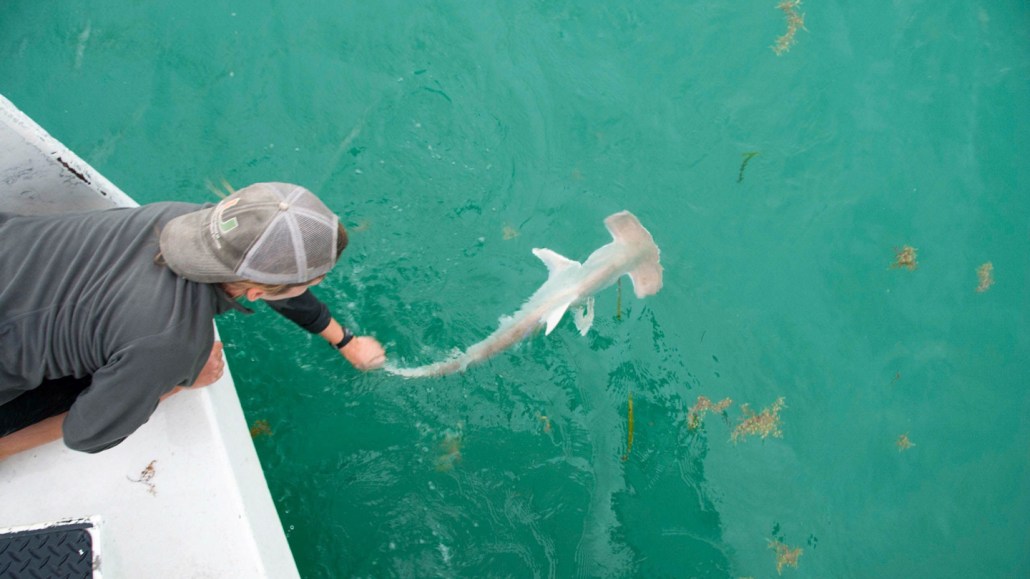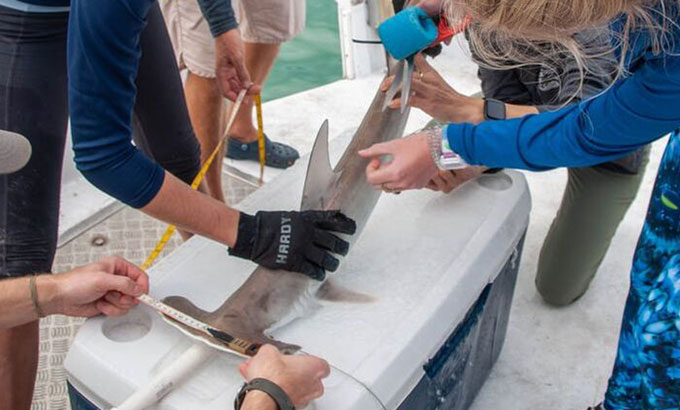A hammerhead shark baby boom near Florida hints at a historic nursery
The nursery of endangered sharks would be the first known in U.S. Atlantic waters

A researcher releases a tagged baby great hammerhead shark into the water just off the coast of Miami. At least nine baby hammerhead sharks have been found in the area, hinting at a possible nursery.
Julia Wester/Field School
- More than 2 years ago
It seems like an unlikely place for a nursery of endangered hammerhead sharks, but a recreational hot spot just off the coast of Miami may host a school of these precious babies. If confirmed, the nursery would be the first ever identified in U.S. Atlantic waters for this iconic shark species.
Finding an endangered shark nursery in a vast ocean is like finding a needle in a haystack. While scientists have used satellites to track migrations of adult great hammerheads (Sphyrna mokarran), where the sharks breed and give birth and where babies grow up is still “a bit of a mystery,” says shark scientist Catherine Macdonald of the University of Miami.
Macdonald investigates where and how sharks can thrive in areas that are heavily impacted by humans. One of those areas is Florida’s Biscayne Bay, a popular spot for fishing and boating that is polluted by urban runoff. There, she and colleagues regularly survey shark abundance and diversity using a catch-and-release system: Sharks that get hooked on baited lines are reeled in, documented, tagged and put back into the water.
Discovering a potential hammerhead shark nursery was an accident. The team got its first inkling of something special in June 2018, when researchers caught a juvenile great hammerhead — an interesting anomaly. In a decade of surveying, the team had never captured a hammerhead in these waters, says David Shiffman, a marine biologist at Arizona State University who is based in Washington, D.C. Several months later, the team caught another young hammerhead.
Over the next year and a half, “we kept catching them … every few months,” Macdonald says. So far, the team has documented nine baby great hammerheads, Macdonald, Shiffman and colleagues report July 11 in Conservation Science and Practice. Based on the sharks’ sizes — all under 200 centimeters long — they were less than 5 years old. The area where the young sharks have been found is fairly shallow and carpeted with seagrass, which probably provides protection and is rife with small fish to eat, the researchers suspect.

Though the Biscayne Bay site seems to be experiencing a hammerhead shark baby boom, officially designating the area as a nursery will require more monitoring. Juvenile sharks are more common at the site than other areas surveyed and the sharks come back to it for multiple years, the team says. But it’s unknown whether the sharks reside at the site for extended periods of weeks or months — the third and final criteria for the site to qualify as a nursery.
Great hammerhead sharks breed infrequently, about once every two years. And the rate at which people catch and kill the sharks — both accidentally and intentionally (SN: 12/1/09) — contributed to the International Union for the Conservation of Nature listing the species as critically endangered in 2019. So when nursery areas are discovered, “it’s important they remain safe,” says marine biologist Jasmin Graham, President and CEO of Minorities in Shark Sciences, an organization that promotes diversity and inclusion in marine science. And while adult sharks have few predators other than people, “there’s a super high mortality rate for juveniles.” With an already unstable population, as many juveniles as possible that can survive to reproductive age is crucial, Graham says.
The possibility of an endangered shark nursery in Biscayne Bay fills Macdonald with hope, and she is working with conservation partners to get legal protections for this important site (SN: 9/17/15). “Even in such a heavily impacted place, it is possible for nature to be thriving,” she says.
Sign up for our newsletter
We summarize the week's scientific breakthroughs every Thursday.





